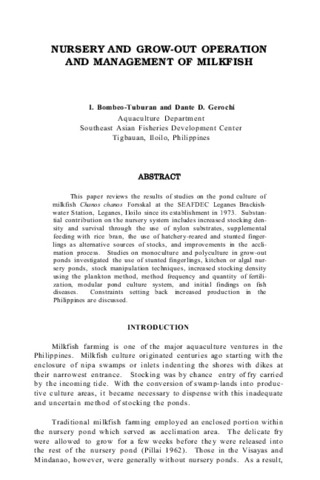Fingerling production of hatchery-reared milkfish (Chanos chanos) in earthen nursery ponds
| dc.contributor.author | Coniza, Eliseo B. | |
| dc.contributor.author | Marte, Clarissa L. | |
| dc.contributor.author | Coloso, Relicardo M. | |
| dc.contributor.author | Huervana, Fredson L. | |
| dc.date.accessioned | 2015-10-10T12:01:26Z | |
| dc.date.available | 2015-10-10T12:01:26Z | |
| dc.date.issued | 2010 | |
| dc.identifier.issn | 0115-5369 | |
| dc.identifier.uri | http://hdl.handle.net/10862/2405 | |
| dc.description.abstract | Fingerling production of milkfish in ponds maybe operated as a commercial enterprise or a component of milkfish farming that comprises nursery, transition and rearing or grow-out phases. The fishpond nursery is used to grow milkfish fry to fingerlings 1-3 g in weight or 1-2 inches in length. The nursery pond is the smallest of the major fishpond compartment ranging from 500 to 5,000 m2, and is about 10% of the total farming area. The pond is prepared with utmost care to eliminate predators and competitors. The area should have good topography, is free from flooding and should have soil with good water retention properties for good dike construction and efficient culture management. Water supply should be adequate year-round and free from pollutants. Good pond water quality is maintained and natural food should be adequate to enhance growth and survival. With high stocking densities, supplemental feed is also provided. The three types of nurseries are based on feed sources: lablab, plankton with supplemental feeding and direct feeding. Select hatchery-reared fry (21 day old) that swim actively in schools, are uniform in size, have robust body, and are resistant to handling and transport stress. The ideal fry stocking density is 5-40 pieces/m2. Survival ranging from 50-90% can be expected after 25-45 days of rearing. Harvest, packing, transport, acclimation and stocking of the fry or fingerlings are carefully done during the cooler part of the day. Economic indicators show that fingerlings production is a profitable business. The improvement of milkfish grow-out technology from extensive or traditional to modified-extensive, semi-intensive and intensive culture in ponds, pens or in sea cages has increased demand for good quality fingerlings. Mass production of hatchery-reared fingerlings in earthen nursery ponds during peak season of fry availability can help bridge the supply gap. A steady supply of fingerlings for a whole year s operation will further increase production and ensure a sustainable supply of affordable market-sized fish. | en |
| dc.format.extent | [iv], 30 p. : ill. | en |
| dc.language.iso | en | en |
| dc.publisher | Aquaculture Department, Southeast Asian Fisheries Development Center | en |
| dc.relation.ispartofseries | Aquaculture extension manual No. 45 | en |
| dc.subject | Chanos chanos | en |
| dc.subject | milkfish | en |
| dc.subject | Philippines | en |
| dc.title | Fingerling production of hatchery-reared milkfish (Chanos chanos) in earthen nursery ponds | en |
| dc.type | Book | en |
| dc.subject.asfa | aquaculture | en |
| dc.subject.asfa | economic analysis | en |
| dc.subject.asfa | economic benefits | en |
| dc.subject.asfa | feeds | en |
| dc.subject.asfa | fingerlings | en |
| dc.subject.asfa | fish culture | en |
| dc.subject.asfa | fish ponds | en |
| dc.subject.asfa | nursery ponds | en |
| dc.subject.asfa | pond culture | en |
| dc.subject.asfa | stocking density | en |
| dc.subject.asfa | milkfish culture | en |
| dc.subject.scientificName | Chanos chanos |
このアイテムのファイル
| ファイル | サイズ | フォーマット | 閲覧 |
|---|---|---|---|
|
このアイテムに関連するファイルは存在しません。 |
|||



